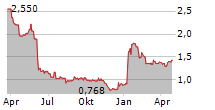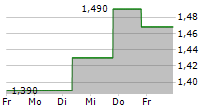
PRESS RELEASE
AB SCIENCE PROVIDES AN UPDATE ON THE DEVELOPMENT OF MASITINIB IN PROGRESSIVE FORMS OF MULTIPLE SCLEROSIS POST ECTRIMS 2024
Paris, 23 September 2024, 5.45pm CET
AB Science SA (Euronext - FR0010557264 - AB) today provides an update on the development of masitinib in progressive forms of multiple sclerosis (MS), following the European Committee for Treatment and Research in Multiple Sclerosis (ECTRIMS) 2024 conference.
The development of masitinib in progressive forms of multiple sclerosis is based on the MAXIMS study (AB20009), a randomized, double-blind, phase 3 study of masitinib 4.5 mg/kg/day in patients with primary progressive multiple sclerosis (PPMS) and non-active secondary progressive multiple sclerosis (nSPMS). The study enrolls patients with Expanded Disability Status Scale (EDSS) score between 3.0 to 6.0, progression of disease for the last 2 years and absence of T1 Gadolinium-enhancing brain lesions. The primary endpoint of the study is the effect of masitinib on time to confirmed disability progression.
The recent results of tolebrutinib in non-active secondary progressive MS presented at the ECTRIMS 2024 conference, reinforce the scientific hypothesis that targeting microglia in nSPMS is a valid approach. Tolebrutinib belongs to a class of drugs that target microglia through an enzymatic target called BTK (Bruton Tyrosine Kinase).
Masitinib also targets microglia but through a different enzymatic target called M-CSFR1 (Macrophage Colony Stimulating Factor Receptor-1) and generated positive results in phase 2B (AB07002) [1], which are consistent with tolebrutinib data.
- EDSS progression confirmed at 3 months was reduced by 37% with masitinib in study AB07002 and by 23% with tolebrutinib in the Hercules study (although the reduction in study AB07002 did not reach the conventional 5% p-value since the study was not powered to detect a significant effect in this secondary endpoint, having 300 patients in the masitinib 4.5 or placebo arms as compared with 1100 patients in the Hercules trial).
- EDSS progression confirmed at 6 months was reduced by 32% with masitinib and by 31% with tolebrutinib.
Importantly,
- Masitinib significantly improved manual dexterity measured by 9-hole Peg test, in study AB07002 (-4,28; p=0,0388).
- Masitinib has shown the ability to decrease serum neurofilament light chain (NfL) concentration in an animal model of MS, and by extension therefore, possibly neuronal damage [2].
- Masitinib not only targets microglia but also mast cells, which play a crucial role in progressive MS and in the experimental autoimmune encephalomyelitis (EAE) model of MS, as shown by numerous publications [3-13].
Masitinib benefits from a large safety database with long-term exposure across various indications. In non-oncology indications, around 2,200 patients have received at least one dose of masitinib, more than 1,300 patients have received masitinib for more than six months and close to 1,000 patients have received masitinib for more than one year.
BTK safety profiles shows increase in liver injury, hypertension and infections which seem to be a class effect, leaving room for alternative drugs.
As a conclusion, masitinib represents a potential credible alternative to BTK inhibitors in the development of new drugs both in primary and non-active secondary progressive MS.
Professor Patrick Vermersch, MD, principal investigator of the MAXIMS study, Director of the Doctoral School Biology-Health of the University of Lille, commented: "Tolebrutinib data are important and pave the way to a series of new drugs in progressive forms of MS. Along with BTK inhibitors, masitinib represents a serious potential alternative in the two forms of progressive MS, primary and non-active secondary progressive MS, which remain the two unmet medical needs. The role of mast cells is not to be neglected in MS".
This new development fits well the strategy currently implemented for masitinib, as it further strengthens the scientific rationale for the development of masitinib in progressive forms of MS as well as the plausibility of the results generated with phase 2B/3 study AB07002.
About the results of the previous phase 2B/3 study AB07002
Study AB07002 met its primary analysis endpoint, demonstrating a statistically significant reduction in cumulative change on EDSS with masitinib 4.5 mg/kg/day (p=0.0256) [1]. This treatment-effect was consistent for PPMS and nSPMS. In addition, masitinib significantly reduced the risk of first disability progression by 42% and the risk of confirmed (3 months) disability progression by 37%. Masitinib also significantly reduced the risk of reaching an EDSS score of 7.0, corresponding to disability severe enough that the patient is restricted to a wheelchair (p=0.0093). The product's safety was consistent with the known risk profile of masitinib, with no elevated risk of infection.
[References]
[1] Vermersch P, Brieva-Ruiz L, Fox RJ, et al. Efficacy and Safety of Masitinib in Progressive Forms of Multiple Sclerosis: A Randomized, Phase 3, Clinical Trial. Neurol Neuroimmunol Neuroinflamm. 2022 Feb 21;9(3):e1148.
[2] Hermine O, Vermersch P, et al. Masitinib limits neuronal damage, as measured by serum neurofilament light chain concentration, in a model of neuroimmune-driven neurodegenerative disease. Preprint. bioRxiv 2024.03.07.583695; doi: https://doi.org/10.1101/2024.03.07.583695
[3] Sandhu JK, Kulka M. Decoding Mast Cell-Microglia Communication in Neurodegenerative Diseases. Int J Mol Sci. 2021 Jan 22;22(3):1093.
[4] Pinke KH, et al. Should mast cells be considered therapeutic targets in multiple sclerosis? Neural Regen Res. 2020 Nov;15(11):1995-2007.
[5] Pinke KH, et al. Calming Down Mast Cells with Ketotifen: A Potential Strategy for Multiple Sclerosis Therapy? Neurotherapeutics. 2020 Jan;17(1):218-234.
[6] Brown MA, Weinberg RB. Mast Cells and Innate Lymphoid Cells: Underappreciated Players in CNS Autoimmune Demyelinating Disease. Front Immunol. 2018;9:514.
[7] Skaper SD, Facci L, Zusso M, Giusti P. An Inflammation-Centric View of Neurological Disease: Beyond the Neuron Front Cell Neurosci. 2018;12:72.
[8] Hendriksen E, et al. Mast cells in neuroinflammation and brain disorders Neurosci Biobehav Rev. 2017;79:119-133.
[9] Elieh-Ali-Komi D, Cao Y. Role of Mast Cells in the Pathogenesis of Multiple Sclerosis and Experimental Autoimmune Encephalomyelitis. Clin Rev Allergy Immunol. 2017;52(3):436-445.
[10] Conti P, Kempuraj D. Important role of mast cells in multiple sclerosis. Mult Scler Relat Disord. 2016;5:77-80.
[11] Skaper SD, Facci L, Giusti P. Mast cells, glia and neuroinflammation: partners in crime?. Immunology. 2014;141(3):314-327.
[12] Skaper SD, et al. Microglia and mast cells: two tracks on the road to neuroinflammation. FASEB J. 2012;26(8):3103-3117.
[13] Zappulla JP, Arock M, Mars LT, Liblau RS. Mast cells: new targets for multiple sclerosis therapy?. J Neuroimmunol. 2002;131(1-2):5-20.
About AB Science
Founded in 2001, AB Science is a pharmaceutical company specializing in the research, development and commercialization of protein kinase inhibitors (PKIs), a class of targeted proteins whose action are key in signaling pathways within cells. Our programs target only diseases with high unmet medical needs, often lethal with short term survival or rare or refractory to previous line of treatment.
AB Science has developed a proprietary portfolio of molecules and the Company's lead compound, masitinib, has already been registered for veterinary medicine and is developed in human medicine in oncology, neurological diseases, inflammatory diseases and viral diseases. The company is headquartered in Paris, France, and listed on Euronext Paris (ticker: AB).
Further information is available on AB Science's website:
www.ab-science.com.
Forward-looking Statements - AB Science
This press release contains forward-looking statements. These statements are not historical facts. These statements include projections and estimates as well as the assumptions on which they are based, statements based on projects, objectives, intentions and expectations regarding financial results, events, operations, future services, product development and their potential or future performance.
These forward-looking statements can often be identified by the words "expect", "anticipate", "believe", "intend", "estimate" or "plan" as well as other similar terms. While AB Science believes these forward-looking statements are reasonable, investors are cautioned that these forward-looking statements are subject to numerous risks and uncertainties that are difficult to predict and generally beyond the control of AB Science and which may imply that results and actual events significantly differ from those expressed, induced or anticipated in the forward-looking information and statements. These risks and uncertainties include the uncertainties related to product development of the Company which may not be successful or to the marketing authorizations granted by competent authorities or, more generally, any factors that may affect marketing capacity of the products developed by AB Science, as well as those developed or identified in the public documents published by AB Science. AB Science disclaims any obligation or undertaking to update the forward-looking information and statements, subject to the applicable regulations, in particular articles 223-1 et seq. of the AMF General Regulations.
For additional information, please contact:
AB Science
Financial Communication & Media Relations
investors@ab-science.com




